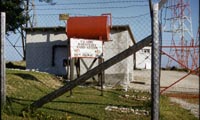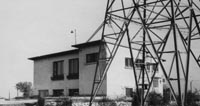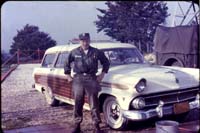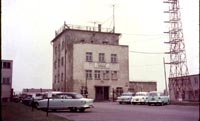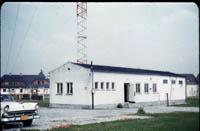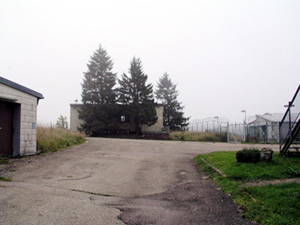| If you do
NOT see the Table of Contents frame to the left of this page, then
Click here to open 'USArmyGermany' frameset |
|||||||||
|
Hohenstadt Radio Station |
|||||||||
|
|
|||||||||
|
|||||||||
|
|
|||||||||
| Hohenstadt Radio Station | |||||||||
|
|||||||||
| 102nd Signal Battalion | |||||||||
| (Email from "Walt" Gelnovatch, 102nd Signal Battalion at Hohenstadt radio site, 1957-59) | |||||||||
| Hohenstadt
Radio Station, Co. B, 102nd Signal Bn
I was privileged to be a member of the staff that operated Hohenstadt Radio Relay Station from June 1957 to June 1959. I would like to share some memories, experiences, observations and comments on our site. My comments reflect the best my memory allows keeping in mind that almost 45 years have passed. Station Personnel The personnel recruited to staff the site usually came directly from Fort Monmouth, N.J., then called the "home of the Signal Corps", after graduation from a 26-week course entitled "Microwave Radio Equipment Repair." The MOS was 281.1 and 281.6 for NCO's. The age demographics and education of the personnel varied greatly. The greater part were young soldiers fresh from the Signal School course, usually PFCs in rank (E3) and usually attaining Specialist Second Class ( E5) rank before going home. All were volunteers (RAs). There were no conscripts as the course length ruled that out. Educational background varied also but was usually included High School, High School plus some college experience and in one case a graduate electrical engineer (BSEE) who had not taken ROTC in college and who subsequently volunteered. Officers were mostly Signal Corps and divided into career or ROTC graduates who were putting in their compulsory service. I don't remember any West Pointers. Within B Company, which was headquartered in Munich (McGraw Kaserne), the CO was a career officer, Capt. Wright. He, interestingly, was infantry and was rumored to have seen action in Korea. The rest of the company grade officers were ROTC including the district officers. I don't remember any OCS graduate officers, possibly because of the technical requirements of the assignment. Most did not have degrees in electrical engineering or the sciences. This left a gaping hole in the engineering leadership within the company which had to be provided for by technical contractors. These civilian contractors ( Americans ) were available only at the company headquarters, Munich for B company. I believe that Philco had the contract to provide these people. Finally, the personnel chosen for duty at the isolated relay sites such as Hohenstadt were supposedly psychologically profiled and filtered while getting technical indoctrination upon arriving at the company level. The purpose of this was to guarantee the compatibility of the personnel at isolated sites with close confinement conditions for long periods in the winter. I could never confirm that this process existed but I can say it didn't work. Technical Aspects The Hohenstadt site was strictly a relay site and hosted only VHF equipment made by the German company Lorenz. I believe that it was installed and originally operated by the 315th Signal Bn. The 315th was rotated to, I believe, Fort Gordon, probably in late 1955 and the 102nd assumed their mission. I don't think any of the personnel changed. Time and events regarding this changeover are hazy and are basically reconstructed from hearsay and old documents residing at the station. |
|||||||||
|
|||||||||
| The most onerous technical task was the so called 10.4 Kc line
up. This consisted of each terminal site, one at a time, transmitting
a 10.4 Kc ( now KHz ) tone which would then 100% modulate the
carrier. Each modulating unit, starting with the originating
transmitter would then have its modulator adjusted until there
was no detected carrier under these drive conditions. It took
me well into graduate school to finally understand the theory
behind it. It turns out that, mathematically, Bessel functions
describe the modulation process in a FM system and that a modulating
signal of the correct audio frequency, corresponding to a root
of the Bessel function ( Bessel function of the second kind
to be exact) completely dissipate the carrier and in our case
guarantee that the modulator was at maximum efficiency. When
finished in one direction the process would be reversed and
repeated from the other direction with one station after another
proceeding in order. These alignments, classically, never went
well. They were the responsibility of the operator on duty at
the monthly prescribed time of the alignment, usually the second
Tuesday of the month. The site chief also attended. As I mentioned
things never went well and a procedure that should probably
never have lasted more than 2 hours sometimes lasted all night. Other problems usually were attributed to the more highly stressed parts such as the two 2500 volt rectifiers. On one occasion I witnessed our resident house cat walk between the above mentioned rectifiers when we left the cabinet doors open after trouble shooting. I stood there in horror as I watched the cat's fur take the shape of the electric field lines between the two tubes, a nice precursor for my later undergraduate studies in fields and waves. The cat made it. Station power was supplied from the commercial German power grid but we had a 40KW German Deutz generator on site for emergencies. The generator had a flywheel that was turned by a electric motor as long as there was commercial power available. When it failed the flywheel which was spring loaded slid along a shaft and engaged a clutch which then turned over the generator. In practice this was almost instantaneous with just a slight flicker of the lights. Usually at this point we looked for the dark smoke coming out of the diesel's exhaust to tell it was operating. The problem was that there were plenty of transients created in the switching process which usually destroyed one or more of the rectifiers in the power supplies. Typically one transmitter of the four operating went off the air. The Site Hohenstadt was located on top of what I remember was 600 + meter high hill, most probably to obtain the first Fresnel clearance conditions for the antennas. This essentially guranteed that the first or main sidelobe of the antenna did not intersect with the ground. There were two antenna towers approximately 200 feet in height pointed in the appropriate directions. The site itself was about 2 acres in size with triple rows of barbed wire and concertina wire surrounding it . It always appeared to me as half finished. An ammunition locker was located at a corner of the property which held carbine ammunition and 30 Caliber machine gun ammunition. We were all assigned a M-1 carbine with a light 30 caliber Browning crew served machinegun available also. How 6 men could ever have defended the site against a determined enemy was beyond me. Since we essentially provided peace time class A telephone service our instructions were to destroy the site in case of war and head to a staging area west of the Rhine. Special combat passes were available in the safe to make sure that an overzealous MP wouldn't shoot us for going in the wrong direction. We were housed in a residential looking building with living facilities upstairs and the operations room in the basement. Heating and hot water were provided by a coal furnace which the operator on duty kept stoked. There were many confrontational disputes in the morning between the night shift operator going off duty and the day operator coming on over the condition of the fire. The locally determined regulation was that the person who let the fire go out had to re-light it. The issue then was the exact definition of a viable and robust fire. Kindling material was at a premium. We once broke up two wooden footlockers to get the fire going in the wintertime. The wall lockers would have been next. Temperatures in the winter sometimes got down to the minus 10 to minus 15 degrees F but the worst was the wind which could reach gale strength with these kind of temperatures. Co-located on the site was a Air Force group of 6 men with identical living facilities operating real microwave equipment from the 12th Radio Relay Squadron. Their tower was 300 foot high and from the top of it one could see the spires of the tallest church in Europe which was in Ulm. Access to the site was by dirt roads leading from the village of Drackenstein and Hohenstadt. These were farming communities of about 300 people. From Drackenstein a blacktop road ran to Gosbach which was lower on the mountain and an access point to the Autobahn. We would make a run daily down these roads and continue on to Geislingen on route 10 and finally to Geoppingen, home of the 8th Infantry Division where we drew all our support from. A side dirt road led from Drackenstein for about one kilometer past a rock quarry to a non authorized entry point to the Autobahn. Located there was the Java Junction PX. where we purchased milk, eggs and light supplies. Java junction was a convenience stop for Americans along the Autobahn and was frequented by the U.S. Army Highway patrol, MP's in white 1957 Chevrolets who patrolled the autobahn. Java Junction was operated by the EES (European Exchange System) for the U.S. military. We usually called the German staff at Java Junction ahead of time to see if any Highway patrol personnel were having donuts and coffee before we went to the facility. Alternately the staff would call the station if they saw any MP's or our Headquarter staff personnel heading for a surprise inspection to our site. However we received more than one citation for being out of uniform or having the trucks excessively dirty from the highway patrol in or around Java Junction. Winters were terrible with lots of snow and cold. Day to Day Life Compared to barracks life as I saw it at McGraw Kaserne in Munich or Robinson Barracks in Stuttgart or even my brief stay at Seckenheim, life at Hohenstadt was good. All of the staff were paid an extra $77 per month to purchase food (Basic Allowance Subsistence) since no mess facilities were available. As I remember we all chipped in $40 which paid for the groceries and a for what I would call a woman of all trades. I think the German word was "Putzfrau" but in reality a housekeeper. Our housekeeper was Elsie, an unflappable older woman who cooked three meals, cleaned the mess we made and generally made the place habitable. The night operator on duty usually picked her up in the morning in time for breakfast. The worst situation was when Elsie came in after a weekend or a long holiday and saw the incredible mess we had made. Her first word was "minch " followed by some undecipherable German expletives. She then rolled up her sleeves and was done cleaning generally by noon. She worked as hard as we did getting ready for inspections. How does one recruit for the position of Putzfrau? Usually word of mouth around the local farming community generated candidates. However there was a unofficial criteria that the candidate had to be older and not glamorous for obvious reasons. The final exam had to be a trip to Munich where the CO would look her over and give his OK. We had many nuisance inspections by battalion officers justifying their trip to Garmisch or to gambling at Baden-Baden. Speaking of inspections, we once bartered cigarettes with the German mechanics at the 8th ID motor pool for a couple of gallons of gloss OD paint and painted a rarely used two and a half ton truck to be our centerpiece "mule" during inspections. The other vehicles could always be designated as in use and away. The whole scheme backfired when some inspecting party member figured out that deuce and a halfs don't get painted gloss. It really looked beautiful though. Aside from pocketing the difference between BAS and the actual $40 that it cost us to live, cigarettes could always be sold to the indigenous population. As I remember everyone received 4 cigarette (carton) stamps a month and if one signed some document attesting to the fact that one was a heavy smoker a fifth stamp was available. The stamps were redeemable at the PX for a dollar a carton cigarettes which could then be sold to the natives for $5. I of course never participated in these egregious activities. In any case the extra funds kept my wife and me eating regularly later throughout undergraduate school. We once banged up a ¾ ton truck and had the German body shop in Gosbach fix it up so it wouldn't have to be reported. An interesting exercise that occurred frequently were USAREUR alerts. These were essentially go to war footing exercises that for us involved loading the trucks for a quick getaway in case we couldn't defend the station. They usually occurred at 0200 hrs and lasted till 0800 hrs. Many a night we had to send out a staff member to scour the local bars and bring our folks back to the station, usually in an ugly mood. Every once in a while the powers that be used these alerts as a mechanism to exchange old occupation money (MPCs) for new ones in order to get the old MPCs out of the black market. The time window was usually 24 hours after which the local American Exchange Office would not exchange the old ones for the new ones. This then necessitated each of the staff journeying to Goeppingen the next day in two shifts since the station had to be manned at all times. Many German taxi drivers and bar owners ended up stuck with non redeemable MPC after a changeover. Most of our news came from listening to AFN Stuttgart, music came from Radio Luxemburg. Since we made daily runs to Goeppingen, Stars and Stripes were also available as were hometown newspapers sent from home. And finally there was the Overseas Weekly which we called the Oversex Weekly for good reasons. AFN provided an interesting service in helping GIs learn German where they would highlight a German word of the day. The format then called for spelling the word, pronouncing it three times and finally using it in a sentence. Finally the announcer would ask you to repeat the word three times. It was mildly educational. However this service gave rise to some hilarious jokes which I won't repeat here, basically derived from using German sounding non words to mimic generally sexually associated situations. Operators worked 2 night shifts, two day shifts, two evening shifts and then were off three days. The site chief worked days only. When repairs to equipment were necessary all of the staff pitched in. By previous arrangement with a colleague it was possible to work 12 days in a row and then be off for 6 days. These extended days off allowed us to tour most of western Europe without using official leave. Most of the staff owned private automobiles but if one didn't then using the resident ¾ ton or the Jeep to go to a town (usually a farm hamlet like Drackenstein) was the norm. We never ventured near a garrison town with Army vehicles and in civilian clothes for obvious reasons. On occasion, a lost MP patrol wandered into Drackenstein and caught one or more of our staff engaged in serious libation. Most of the staff were single and had local girlfriends who usually came up to see the movies that we showed in the evening. We usually received 5 movies a week. I met my wife while at Hohenstadt and we enjoyed many good movies and the social ambiance. The land around the station was farmed and when the German farmers emptied their sewage tanks into honey wagons and then poured the contents on the vegetables in the fields two things happened. First the vegetables grew like crazy probably making up for the disadvantage of farming at that altitude. Second the smell was overpowering inside the station and smelled mildly like a failing selenium rectifier in the equipment sending all the staff on a hunt for a failing component until the outside source was located. We had the constant camaraderie of the Air Force contingent next door. In fact I still have periodic lunches with Mr. Ron Zimmer of the 12th Radio Relay Sqdn. who lives near me in New Jersey and has remained a lifelong friend. The site chief was a fellow by the name of SFC. Norm Jorstadt. who as a young 19 year old Marine had fought in Guadalcanal. During one of our inspections he was chewed out for not wearing his ribbons by a young "shavetail". At the next inspection I counted 6 rows of ribbons. Jorstadt had his family with him on this tour and they all lived in Goeppingen, courtesy of the 8th Infantry Division. He commuted to work each day at the site. He had taken over the site at about the time I arrived, taking over for the previous site chief who ran afoul of the few restrictions that we actually had. Most week days the staff member due to work the night shift took a truck to Goeppingen to pick up mail, movies and supplies. We had in our possession in the site safe, military gasoline stamps and took on fuel either in Goeppingen or at a quartermaster station on the autobahn near us. As best as I can remember the names of the other site personnel were as follows: Norbert Binkowski (New York State), Bob Shirley (Arkansas), Ed Tocker (New York City), Al Goldstein (his identical twin was in Stuttgart), Baltimore. EPILOG It's been 44 years since I left Hohenstadt. I haven't met many of my comrades. We were all very young then and made plans for the future collectively. Many were going to college after the enlistment ended to pursue technical degrees. In reality very few did as family and other obligations intervened. Over the years I met a few. Norm Binkowski visited my laboratory in the 1980's, he had gotten his BSEE and worked for Kodak in Buffalo, N.Y. John Risko, a name that I didn't mention previously, and who I had graduated with from Microwave Radio Equipment Repair School at Fort Monmouth, received his BSEE and worked at RCA Sarnoff Labs. I attended Al Goldstein's wedding in Baltimore shortly after I returned home but lost touch after that. After a long hiatus, a dear friend and I recently reacquainted ourselves. His name was Dale Calnon and he lives in Lykins, Pa. We were inseparable at the Signal School and shipped over on the same boat (Rose or Upshur, I don't remember if the names are spelled correctly or if it's in the correct sequence). He was posted to the terminal site at Stuttgart and we remained constantly in contact on the engineering channel and took many vacation trips throughout Europe. I have remained in sporadic contact with two members of the AF contingent at Hohenstadt, Don Carscadden who I visited in Seattle on a business trip and Leonard Jones who I spoke to via telephone last year. Jones lives in Iowa. As for myself, when my wife and I returned home in the summer of 1959 I went back to undergraduate school followed by graduate schools where I earned advanced degrees in electrical engineering. My first position after graduation was (of all places) at the Signal Corps Engineering Labs at Fort Monmouth were I stayed until 1997 retiring as the director of the Army's Electronic Technology and Devices Laboratory. Working at the Labs in fundamental electron device research did not put me in a position to follow or visit the 102nd Signal Bn. and I only encountered a major who worked for me that was an alumnus of the 102nd. This was in the 1980s when the Bn. had moved on to another mission. It was an honor and privilege to be associated with the US Army for all those years in the defense of our great country. Looking back I now realize that service with the 102nd Signal Bn. essentially shaped my whole later professional career. |
|||||||||
|
|
|||||||||
| (Email from "Walt" Gelnovatch, 102nd Signal Battalion at Hohenstadt radio site, 1957-59) | |||||||||
| Return to Hohenstadt, 2004 After an absence of 45 years, I visited Hohenstadt Radio Station in October 2004. It was an emotional experience for me given that I spent two of my youthful impressionistic years there. Additionally, I met my wife there and probably established most of my future professional career aspirations. HOHENSTADT RADIO STATION I drove from Munich much in the way I did when coming back from a visit to Co. B HQ. The SOP at this point usually involved pulling off the Autobahn (now called A8) at the Java Junction rest stop which was an American PX located on an old Autobahn rest stop. The next step was circling around to the back of the PX where there was a dirt road which led past a quarry and which obviously was an unauthorized exit and finally taking it to Hohenstadt Radio Station. This saved at least 5 to 7 miles from the normal route. The first problem was that the PX building was gone, really gone. My wife, who was the manager at the PX, and I searched for the remains of the building for at least half an hour to no avail. Even though we tried to triangulate the location using our collective recollections we failed miserably. Next we tried to locate the quarry road, again failure; there was a solid line of good sized trees and brush edging the rest stop. At this point we decided to take the good house keeping approved method which called for taking the Autobahn north down into the valley, getting off at the Muhlhausen exit, going through Gosbach and then proceeding to climb back up the mountain over some breath taking roads. Incidentally we took on gasoline at a garage in Gosbach where in 1957 we paid out of our pockets to fix a wrecked ¾-ton Army truck so it would not have to be reported to the Army authorities. |
|||||||||
|
|||||||||
| The Air Force 300-foot tower is gone as well as the two shorter Army UHF/VHF antenna towers. Our old systems pointed in different directions including south to Hohenpeissenberg and north toward Stuttgart and Koenigstuhl (Heidelberg). I suspect that Hohenstadt, because of its geographic location and height became a sought after relay location for newer systems. Further, over the last 45 years and specifically after the 102nd gave up the USAREUR Multichannel Radio Telephone mission, the site became the asset of various regional Signal Units. I read that at a time, probably in the 1970s, it belonged to the Goeppingen military district, the 68th Signal Bn. and the 69th Signal Bn. Moving on, the site now had 3 new large buildings and it appeared that the real estate had been expanded slightly to accommodate these structures. I don't remember us owning so much land then, specially behind the two main buildings. One of the new buildings was between the gate and the access road (to the right of the gate looking in) where previously we had a large field and a nice view of the town of Ober Drackenstein and where, in the corner was the ammunition locker. The road from Ober Drackenstein to Hohenstadt (village) is now paved. The station was actually half way between the two. In the gently downward sloping fields flowing away from the station, the fields appear not to be farmed anymore and a small development of houses has sprung up on the North side and across the road. I attempted to ring the gate bell because we did spot one civilian auto hidden behind one of the buildings. A very disagreeable German civilian rent-a-cop appeared and attempted to get rid of us. Since I had on a Bavarian leather sport jacket and my relatives all had German license plates I attempted to explain to him that I was an American stationed here and would love to engage him in some small talk. This had an even more disruptive effect on him and we soon exchanged unkind words and parted. I walked around, while the rent-a-cop ran from window to window following me. The weather was cold (below 40º F) and foggy, the classic weather that I remember we had an excess of. At this point my nephew was getting nervous at the possible prospect of the rent-a-cop calling the German police so we beat a hasty retreat to Ober Drackenstein where my wife together with my brother-in-law were looking for familiar places and faces. OBER DRACKENSTEIN Ober Drackenstein was the town where most of us from the station partook in R&R. I don't know why we didn't patronize Hohenstadt. The center of social intercourse for our site personnel was Krone's Gausthaus. It was managed by a young lady named Alvina on behalf of her parents who owned the enterprise. My wife knew her well and looked for her but was unable to find her when we visited her house. We did run into her husband who actually remembered my wife and addressed her by her maiden name. As it turned out they had a daughter who grew up and married a soldier from the station and moved to the US. Small world! We located the house where my wife rented a room when she was working at the PX at Java Junction. Finally my nephew and I found the quarry road from the Ober Drackenstein end and determined that it actually passed within 100 feet of the old Java Junction rest stop but was now made inaccessible. Ober Drackenstein was a rugged farming community of about 300 people in 1957. Today it looks like it has doubled in size with many new high quality homes. The signs of farming are few to non-existent and it looks as though yuppies from the cities have moved in to enjoy the peace and quiet of this small visit. No honey wagons were visible! McGRAW KASERNE, MUNICH I also visited McGraw Kaserne in Munich which was Co. B HQ. It is now abandoned by the US military except the buildings bordered by the University of Maryland and the old US HQ which is now occupied by the German State or city police. Try as I may I couldn't remember the location of my personal digs or the exact barracks we occupied. I walked around the periphery of the Kaserne and I think I found the residential houses that I could see from my window. Additionally I could not find the actual Munich Terminal site. The tall antenna tower is gone so there was no visual marker and the spacious lot on which it stood appears to have been developed commercially. I believe, from a bronze plaque at the McGraw HQ. Building, that McGraw Kaserne was abandoned in 1992. Also a sunken expressway cuts right through the Kaserne now. SOME OBSERVATIONS I probably should have put some more planning into visiting Hohenstadt by contacting some of my former and still on active duty colleagues that I worked with at the Signal Corps labs over the years and possibly arranged an official site visit. But in retrospect that probably wound not have changed anything. Someone once offered a comment to the effect that "you can't ever go home again." It was probably just sufficient emotionally to look in from the outside. I was glad I went and probably will never see Hohenstadt Radio Station again. I have attached some photos and would enjoy any communication with interested parties. |
|||||||||
| 12th Radio Relay Squadron | |||||||||
| Webmaster
Notes: OL 12-42
(or Operating Location 42, 12th Radio Relay Squadron) was the Air
Force detachment located at Hohenstadt. Similar to their Army peers,
this small group of personnel operated as a radio relay station, picking
up signals from another relay station, amplifying the signal and then
sending it on to the next station down the chain of line-of-site stations.
For this AF site, the mission was to relay incoming and outgoing signals
between Friolzheim (OL 12-41) to the northwest and Markt Wald (OL
12-37) in the southeast. Also linked to Hohenstadt was the OL at Türkheim,
where a USAF radar site was located. Like several other hilltops and mountain peaks spread out over southern, central and northern German, Hohenstadt had been identified by both the Army as well as the Air Force as being well suited as a radio relay point for their respective communications links. Thus Air Force and Army personnel worked side-by-side performing their mission. |
|||||||||
|
|||||||||
|
|
|||||||||
| 68th Signal Battalion | |||||||||
| 69th Signal Battalion | |||||||||
| (Source: STARS & STRIPES, May 17, 1981) | |||||||||
| 26 soldiers from the 252nd Signal Co, 69th Sig Bn, in Neu Ulm are assigned to the Hohenstadt detachment. The Hohenstadt Radio Relay Site is a critical communication site on the DCS mainline in Germany. Approximately 90 percent of all electronic communications to the southern portion of the European Command passes via the 320 communications channels maintained by the relay site. The radio station is located at an altitude of 2,400 feet and is about 27 miles south of Goeppingen. The site has its own dormitory, dining hall, senior BEQ, recreation room, and small PX. |
|||||||||



